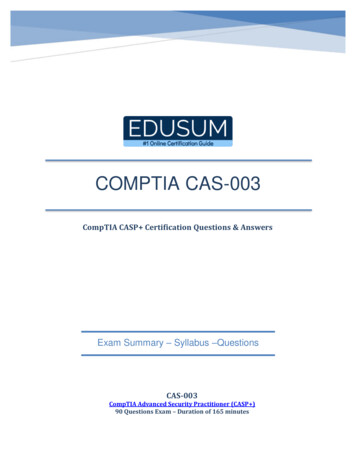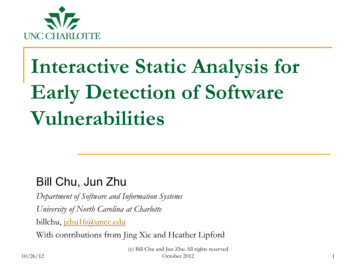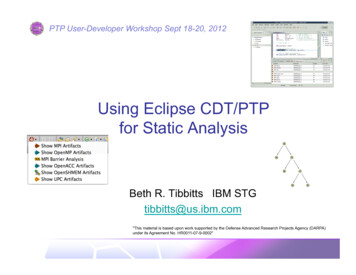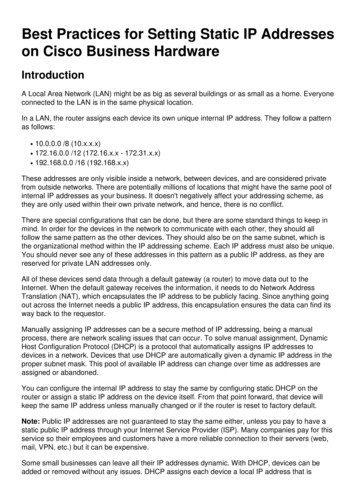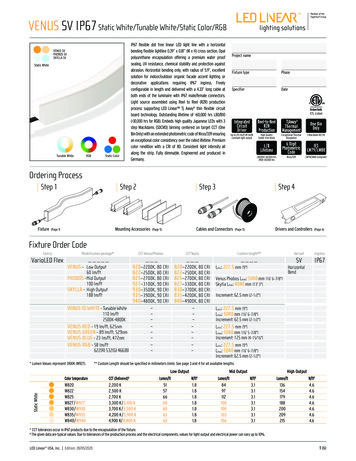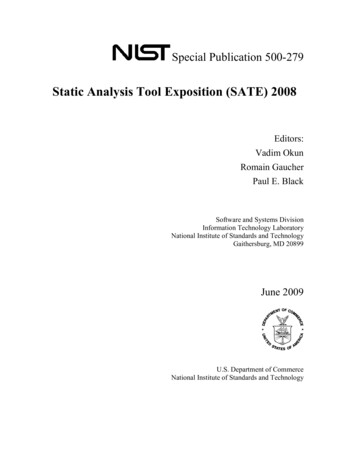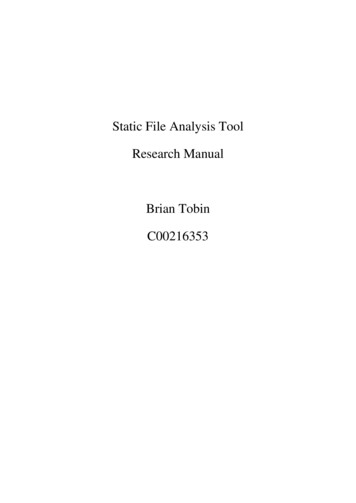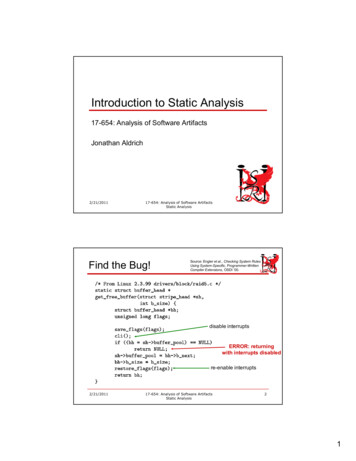
Transcription
CAS Static Analysis Tool Study MethodologyCenter for Assured SoftwareNational Security Agency9800 Savage RoadFort George G. Meade, MD 20755-6738cas@nsa.govDecember 2012-i-
WarningsTrade names or manufacturers’ names are used in this report for identification only. This usagedoes not constitute an official endorsement, either expressed or implied, by the National SecurityAgency.References to a product in this report do not imply endorsement by the National Security Agencyof the use of that product in any specific operational environment, to include integration of theproduct under evaluation as a component of a software system.References to an evaluation tool, technique, or methodology in this report do not implyendorsement by the National Security Agency of the use of that evaluation tool, technique, ormethodology to evaluate the functional strength or suitability for purpose of arbitrary softwareanalysis tools.Citations of works in this report do not imply endorsement by the National Security Agency orthe Center for Assured Software of the content, accuracy or applicability of such works.References to information technology standards or guidelines do not imply a claim that theproduct under evaluation is in conformance or nonconformance with such a standard orguideline.References to test data used in this evaluation do not imply that the test data was free of defectsother than those discussed. Use of test data for any purpose other than studying static analysistools is expressly disclaimed.This report and the information contained in it may not be used in whole or in part for anycommercial purpose, including advertising, marketing, or distribution.This report is not intended to endorse any vendor or product over another in any way.Trademark InformationMicrosoft and Windows are either registered trademarks or trademarks of Microsoft Corporationin the United States and/or other countries.MITRE is a registered trademark of The MITRE Corporation.Apache is a registered trademark of the Apache Software Foundation.- ii -
Table of ContentsSection 1: Introduction .21.1 Background .21.2 Center for Assured Software (CAS) .21.3 Feedback .2Section 2: Methodology .32.1 Overview .32.2 Test Cases .32.3 Weakness Classes .32.3.1 Authentication and Access Control .42.3.2 Code Quality .42.3.3 Control Flow Management .52.3.4 Encryption and Randomness.52.3.5 Error Handling .52.3.6 File Handling .52.3.7 Information Leaks .52.3.8 Initialization and Shutdown .62.3.9 Injection .62.3.10 Malicious Logic .62.3.11 Number Handling.62.3.12 Pointer and Reference Handling .62.4 Assessment .72.4.1 Tool Execution .72.4.2 Scoring Results .72.5 Metrics .72.5.1 Precision, Recall, and F-Score .72.5.2 Discriminations and Discrimination Rate .9Section 3: Reporting .113.1 Results by Tool .113.1.1 Precision, Recall, and F-Score Table .113.1.2 Precision Graph by Weakness Class .133.1.3 Recall Graph by Weakness Class .143.1.4 Precision-Recall Graph by Tool.153.1.5 Discriminations and Discrimination Rate Table by Weakness Class .173.1.6 Discrimination Rate Graph by Weakness Class .183.2 Results by Weakness Class .193.2.1 Precision Graph by Weakness Class .193.2.2 Recall Graph by Weakness Class .203.2.3 Precision-Recall Graph by Weakness Class .203.2.4 Discrimination Rate Graph by Weakness Class .233.2.5 Precision-Recall and Discrimination Results by Weakness Class .243.3 Combined Tool Results.243.3.1 Combination of Two Tools .243.3.2 Multiple Tool Coverage .26- iii -
Section 4: CAS Tool Study .294.1 Tool Run .294.1.1 Test Environment .294.1.2 Tool Installation and Configuration .294.1.3 Tool Execution and Conversion of Results .294.1.4 Scoring of Tool Results .294.1.5 Metrics .304.1.6 Precision .304.1.7 Recall .304.1.8 F-Score .304.1.9 Weighting .31Appendix A : Juliet Test Case CWE Entries and Weakness Classes . A-1- iv -
AbstractThe primary mission of the National Security Agency’s (NSA) Center for Assured Software(CAS) is to increase the degree of confidence that software used within the Department ofDefense (DoD) is free from exploitable vulnerabilities. Over the past several years, commercialand open source static analysis tools have become more sophisticated at being able to identifyflaws that can lead to such vulnerabilities. As these tools become more reliable and popular withdevelopers and clients, the need to fully understand their capabilities and shortcomings isbecoming more important.To this end, the CAS regularly conducts studies using a scientific, methodical approach thatmeasures and rates effectiveness of these tools in a standard and repeatable manner. The CASStatic Analysis Tool Study Methodology is based on a set of artificially created known answertests that comprise examples of “intentionally flawed code.” Each flawed example, with theexception of specific test cases, has at least one corresponding construct that is free from thatspecific flaw. In applying the methodology, the tester analyzes all tools using this commontesting corpus. The methodology then offers a common way to “score” the tools’ results so thatthey are easily compared. With this known answer approach, testers can have full insight intowhat a tool should report as a flaw, what it misses, and what it actually reports. The CAS hascreated and released the test corpus to the community for analysis, testing, and adoption.1This document provides a step by step description of this methodology in the hope that it canbecome part of the public discourse on the measurement and performance of static analysistechnology. In addition, this document shows the various reporting formats used by the CASand provides an overview of how the CAS administers its tool study. It is available for publicconsumption, comment and adoption. Comments and suggestions on the methodology can besent to CAS@nsa.gov.1This test suite is available as the “Juliet Test Suite” and is publicly available through the National Institute forStandards and Technology (NIST) at http://samate.nist.gov/SRD/testsuite.php.-1-
Section 1: Introduction1.1 BackgroundSoftware systems support and enable mission-essential capabilities in the Department ofDefense. Each new release of a defense software system provides more features and performsmore complex operations. As the reliance on these capabilities grows, so does the need forsoftware that is free from intentional or accidental flaws. Flaws can be detected by analyzingsoftware either manually or with the assistance of automated tools.Most static analysis tools are capable of finding multiple types of flaws, but the capabilities oftools are not necessarily uniform across the spectrum of flaws they detect. Even tools that targeta specific type of flaw are capable of finding some variants of that flaw and not others. Tools’datasheets or user manuals often do not explain which specific code constructs they can detect,or the limitations and strengths of their code checkers. This level of granularity is needed tomaximize the effectiveness of automated software evaluations.1.2 Center for Assured Software (CAS)In order to address the growing lack of Software Assurance in the DoD, the NSA’s CAS wascreated in 2005. The CAS’s mission is to improve the assurance of software used within theDoD by increasing the degree of confidence that software is free from intentional andunintentional vulnerabilities. The CAS accomplishes this mission by assisting organizations indeploying processes and tools to address assurance throughout the Software Development LifeCycle (SDLC).As part of an overall secure software development process, the CAS advocates the use of staticanalysis tools at various stages in the SDLC, but not as a replacement for other softwareassurance efforts, such as manual code reviews. The CAS also believes that some organizationsand projects warrant a higher level of assurance that can be gained through the use of more thanone static analysis tool.The CAS is responsible for performing an annual study on the capabilities of automated, flawfinding static analysis tools. The results of these studies assist software development teams withthe selection of a tool for use in their SDLC.1.3 FeedbackThe CAS continuously tries to improve its methodology for running these studies. As you readthis document, if you have any feedback or questions on the information presented, pleasecontact the CAS via email at cas@nsa.gov.-2-
Section 2: Methodology2.1 OverviewThe CAS methodology consists of using artificial code in the form of test cases to perform staticanalysis tool evaluations. Each test case targets a specific flaw. These test cases are grouped withsimilar flaw-types into Weakness Classes. After each tool scans the test suite, the results arethen scored, analyzed, and presented in a programming language-specific report. The followingparagraphs explain each aspect of the methodology in greater detail.2.2 Test CasesIn order to study static analysis tools, evaluators need software for the tools to analyze. Thereare two types of software to choose from: natural and artificial. Natural software is software thatwas not created to test static analysis tools. Open source software applications, such as theApache web server (httpd.apache.org) or the OpenSSH suite (www.openssh.com) are examplesof natural software. Artificial software contains intentional flaws and is created specifically totest static analysis tools.The CAS decided that the benefits of using artificial code outweighed the disadvantages andtherefore created artificial code to study static analysis tools. The CAS generates the source codeas a collection of test cases. Each test case contains exactly one intentional flaw and typically atleast one non-flawed construct similar to the intentional flaw. The non-flawed constructs areused to determine if the tools could discriminate flaws from non-flaws. For example, one testcase illustrates a type of buffer overflow vulnerability. The flawed code in the test case passesthe C strcpy function a destination buffer that is smaller than the source string. The non-flawedconstruct passes a large enough destination buffer to strcpy.The test cases created by the CAS and used to study static analysis tools are called the Juliet TestSuites. They are publicly available through the National Institute for Standards and Technology(NIST) at http://samate.nist.gov/SRD/testsuite.php.2.3 Weakness ClassesTo help understand the areas in which a given tool excelled, similar test cases are grouped into aWeakness Class. Weakness Classes are defined using the MITRE Common WeaknessEnumeration (CWE)2 entries that contain similar flaw types. Since each Juliet test case isassociated with the CWE entry in its name, each test case is contained in a Weakness Class.For example, Stack-based Buffer Overflow (CWE-121) and Heap-based Buffer Overflow(CWE-122) are both placed in the Buffer Handling Weakness Class. Therefore, all of the testcases associated with CWE entries 121 and 122 are mapped to the Buffer Handling Weakness2The MITRE CWE is a community-developed dictionary of software weakness types and can be found athttp://cwe.mitre.org-3-
Class. Table 1 provides a list of all the Weakness Classes used in the study, along with anexample of each.Weakness ClassExample Weakness (CWE Entry)Authentication and Access ControlBuffer Handling (C/C only)Code QualityControl Flow ManagementEncryption and RandomnessCWE-259: Use of Hard-coded PasswordCWE-121: Stack-based Buffer OverflowCWE-561: Dead CodeCWE-483: Incorrect Block DelimitationCWE-328: Reversible One-Way HashError HandlingFile HandlingInformation LeaksInitialization and ShutdownInjectionMalicious LogicCWE-252: Unchecked Return ValueCWE-23: Relative Path TraversalCWE-534: Information Exposure Through Debug Log FilesCWE-404: Improper Resource Shutdown or ReleaseCWE-134: Uncontrolled Format StringCWE-506: Embedded Malicious CodeNumber HandlingPointer and Reference HandlingCWE-369: Divide by ZeroCWE-476: NULL Pointer DereferenceTable 1 – Weakness ClassesThe Miscellaneous Weakness Class, which was used to hold a collection of individualweaknesses that did not fit into the other classes, was re-evaluated in 2012. Based upon theirimplementation and to alleviate any confusion regarding the nature of the test cases in thiscategory, the CAS felt these test cases could be re-categorized within the other WeaknessClasses.The following paragraphs provide a brief description of the Weakness Classes defined by theCAS.2.3.1 Authentication and Access ControlAttackers can gain access to a system if the proper authentication and access control mechanismsare not in place. An example would be a hardcoded password or a violation of the least privilegeprinciple. The test cases in this Weakness Class test the tools’ ability to check whether or not thesource code is preventing unauthorized access to the system.2.3.2 Code QualityCode quality issues are typically not security related; however, they can lead to maintenance andperformance issues. An example would be unused code. While this is not an inherent securityrisk, it may lead to maintenance issues in the future. The test cases in this Weakness Class testthe tools’ ability to find poor code quality issues in the source code.The test cases in this Weakness Class cover some constructs that may not be relevant to allaudiences. The test cases are all based on weaknesses in CWEs, but even persons interested in-4-
code quality may not consider some of the tested constructs to be weaknesses. For example, thisWeakness Class includes test cases for flaws such as an omitted break statement in a switch, amissing default case in a switch, and dead code.2.3.3 Control Flow ManagementControl flow management deals with timing and synchronization issues that can causeunexpected results when the code is executed. An example would be a race condition. Onepossible consequences of a race condition is a deadlock which leads to a denial of service. Thetest cases in this Weakness Class test the tools’ ability to find issues in the order of executionwithin the source code.2.3.4 Encryption and RandomnessEncryption is used to provide data confidentiality. However, if a weak or wrong encryptionalgorithm is used, an attacker may be able to convert the ciphertext into its original plain text. Anexample would be the use of a weak Pseudo Random Number Generator (PRNG). Using a weakPRNG could allow an attacker to guess the next number that is generated. The test cases in thisWeakness Class test the tools’ ability to check for proper encryption and randomness in thesource code.2.3.5 Error HandlingError handling is used when a program behaves unexpectedly. However, if a program fails tohandle errors properly it could lead to unexpected consequences. An example would be anunchecked return value. If a programmer attempts to allocate memory and fails to check if theallocation routine was successful, then a segmentation fault could occur if the memory failed toallocate properly. The test cases in this Weakness Class test the tools’ ability to check for propererror handling within the source code.2.3.6 File HandlingFile handling deals with reading from and writing to files. An example would be reading from auser-provided file on the hard disk. Unfortunately, adversaries can sometimes provide relativepaths that contain periods and slashes. An attacker can use this method to read to or write to afile in a different location on the hard disk than the developer expected. The test cases in thisWeakness Class test the tools’ ability to check for proper file handling within the source code.2.3.7 Information LeaksInformation leaks can cause unintended data to be made available to a user. For example,developers often use error messages to inform users that an error has occurred. Unfortunately, ifsensitive information is provided in the error message an adversary could use it to launch futureattacks on the system. The test cases in this Weakness Class test the tools’ ability to check forinformation leaks within the source code.-5-
2.3.8 Initialization and ShutdownInitializing and shutting down resources occurs often in source code. For example, in C/C ifmemory is allocated on the heap it must be deallocated after use. If the memory is notdeallocated, it could cause memory leaks and affect system performance. The test cases in thisWeakness Class test the tools’ ability to check for proper initialization and shutdown ofresources in the source code.2.3.9 InjectionCode injection can occur when user input is not validated properly. One of the most commontypes of injection flaws is cross-site scripting (XSS). An attacker can place query strings in aninput field that could cause unintended data to be displayed. This can often be prevented usingproper input validation and/or data encoding. The test cases in this Weakness Class test the tools’ability to check for injection weaknesses in the source code.2.3.10 Malicious LogicMalicious logic is the implementation of a program that performs an unauthorized or harmfulaction. In source code, unauthorized or harmful actions can be indicators of malicious logic.Examples of malicious logic include Trojan horses, viruses, backdoors, worms, and logic bombs.The test cases in this Weakness Class test the tools’ ability to check for malicious logic in thesource code.2.3.11 Number HandlingNumber handling issues include incorrect calculations as well as number storage andconversions. An example is an integer overflow. On a 32-bit system, a signed integer’smaximum value is 2,147,483,647. If this value is increased by one, its new value will be anegative number rather than the expected 2,147,483,648 due to the limitation of the number ofbits used to store the number. The test cases in this Weakness Class test the tools’ ability tocheck for proper number handling in the source code.2.3.12 Pointer and Reference HandlingPointers are often used in source code to refer to a block of memory without having to referencethe memory block directly. One of the most common pointer errors is a NULL pointerdereference. This occurs when the pointer is expected to point to a block of memory, but insteadit points to the value of NULL. This can cause an exception and lead to a system crash. The testcases in this Weakness Class test the tools’ ability to check for proper pointer and referencehandling.-6-
2.4 Assessment2.4.1 Tool ExecutionThe CAS regularly evaluates commercial and open source static analysis tools with the use of theJuliet Test Suites. The tools are installed and configured on separate hosts with a standardized setof resources in order to avoid conflicts and allow independent analysis. Every tool is executedusing its command-line interface (CLI) and the results are exported upon completion.2.4.2 Scoring ResultsIn order to assess the tool’s performance, tool results are scored using result types. Table 2contains the various result types that can be assigned as well as their definitions.Result TypeExplanationTrue Positive (TP)Tool reports the intentionally-flawed code.False Positive (FP)Tool reports the non-flawed code.False Negative (FN)Tool fails to report the intentionally-flawed code.Table 2 – Summary of Result TypesFor example, consider a test case that targets a buffer overflow flaw. The test case containsintentionally-flawed code that attempts to place data from a large buffer into a smaller one. If atool reports a buffer overflow in this code then the result is marked as a True Positive. The testcase also contains non-flawed code that is similar to the flawed code, but prevents a bufferoverflow. If a tool reports a buffer overflow in this code then the result is marked as a FalsePositive. If the tool fails to report a buffer overflow in the intentionally-flawed code, then theresult is marked as a False Negative. If a tool reports any other type of flaw, for example amemory leak, in the intentionally-flawed or non-flawed code, then the result type is consideredan incidental flaw as it is not the target of the test case. Incidental flaws are excluded fromscoring.2.5 MetricsMetrics are used to perform analysis of the tool results. After the tool results have been scored,specific metrics can be calculated. Several metrics used by the CAS are described in thefollowing paragraphs.2.5.1 Precision, Recall, and F-ScoreOne set of metrics contains the Precision, Recall, and F-Scores of the tools based on the numberof True Positive (TP), False Positive (FP), and False Negative (FN) findings for that tool. Thefollowing paragraphs describe these metrics in greater detail.-7-
PrecisionIn the context of the methodology, Precision (also known as “positive predictive value") is theratio of weaknesses reported by a tool to the set of actual weaknesses in the code analyzed. It isdefined as the number of weaknesses correctly reported (True Positives) divided by the totalnumber of weaknesses actually reported (True Positives plus False Positives).Precision # TP# TP # FPPrecision is synonymous with the True Positive rate and is the complement of the False Positiverate. It is also important to highlight that Precision and Accuracy are not the same. In thismethodology, Precision describes how well a tool identifies flaws, whereas accuracy describeshow well a tool identifies flaws and non-flaws as well.Note that if a tool does not report any weaknesses, then Precision is undefined, i.e. 0/0. Ifdefined, Precision is greater than or equal to 0, and less than or equal to 1. For example, a toolthat reports 40 issues (False Positives and True Positives), of which only 10 are real flaws (TruePositives), has a Precision of 10 out of 40, or 0.25.Precision helps users understand how much trust can be given to a tool's report of weaknesses.Higher values indicate greater trust that issues reported correspond to actual weaknesses. Forexample, a tool that achieves a Precision of 1 only reports issues that are real flaws in the testcases. That is, it does not report any False Positives. Conversely, a tool that has a Precision of 0always reports issues incorrectly. That is, it only reports False Positives.RecallThe Recall metric (also known as "sensitivity" or “soundness”) represents the fraction of realflaws reported by a tool. Recall is defined as the number of real flaws reported (True Positives),divided by the total number of real flaws – reported or unreported – that exist in the code (TruePositives plus False Negatives).Recall #TP#TP # FNRecall is always a value greater than or equal to 0, and lesser than or equal to 1. For example, atool that reports 10 real flaws in code that contains 20 flaws has a Recall of 10 out of 20, or 0.5.A high Recall means that the tool correctly identifies a high number of the target weaknesseswithin the test cases. For example, a tool that achieves a Recall of 1 reports every flaw in the testcases. That is, it has no False Negatives. (While a Recall of 1 indicates all of the flaws in thetest cases were detected, notice that this metric does not account for the number of FalsePositives that may have been produced by the tool.) In contrast, a tool that has a Recall of 0reports none of the real flaws. That is, it has a high False Negative rate.-8-
F-ScoreIn addition to the Precision and Recall metrics, an F-Score is calculated by taking the harmonicmean of the Precision and Recall values. Since a harmonic mean is a type of average, the valueof the F-Score will always be between the Precision and Recall values (unless the Precision andRecall values are equal, in which case the F-Score will be that same value). Note that theharmonic mean is always less than the arithmetic mean (again, unless the Precision and Recallare equal).The F-Score provides weighted guidance in identifying a good static analysis tool by capturinghow many of the weaknesses are found (True Positives) and how much noise (False Positives) isproduced. An F-Score is computed using the following formula: Precision Recall F -Score 2 Precision Recall A harmonic mean is desirable since it ensures that a tool must perform reasonably well withrespect to both Precision and Recall metrics. In other words, a tool will not get a high F-Scorewith a very high score in one metric but a low score in the other metric. Simply put, a tool that isvery poor in one area is not considered stronger than a tool that is average in both.2.5.2 Discriminations and Discrimination RateAnother set of metrics measures the ability of tools to discriminate between flaws and non-flaws.This set of metrics is helpful in differentiating unsophisticated tools performing simple patternmatching from tools that conduct a more complex analysis.For example, consider a test case for a buffer overflow where the flaw uses the strcpy functionwith a d
Static Analysis Tool Study Methodology is based on a set of artificially created known answer tests that comprise examples of "intentionally flawed code." Each flawed example, with the exception of specific test cases, has at least one corresponding construct that is free from that .

